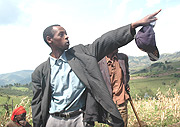Obliteration of Tutsi Before the genocide, preparations had already reached advanced stages. Death lists had been compiled. Trial massacres were conducted; both as training for the perpetrators of genocide to test whether there would be any response such as arrests, international denunciation, or sanctions.


Obliteration of Tutsi
Before the genocide, preparations had already reached advanced stages. Death lists had been compiled. Trial massacres were conducted; both as training for the perpetrators of genocide to test whether there would be any response such as arrests, international denunciation, or sanctions.
If murders were to get away with their crimes, if there was to be impunity, it was a green light to go on with the genocide. In preparation for the genocide, tools and weapons were acquired.
For example, machetes often-referred to as traditional weapons (Intwaro gakondo) were imported mainly from China and from other suppliers, which was manifested by the discovery in January 1993 in the former Kibungo province.
Crates of machetes were discovered in a lorry from Nairobi. Trial massacres, which began immediately after RPF/A started the liberation war in October 1991, were conducted in Kibirira. Hundreds of Tutsi were killed.
In 1992, more than 1000 Tutsi were massacred in Kinigi and Bugesera respectively.
The government supported all these massacres, and hence no body was arrested for the crimes. The government however does not stand a lone as the accused accomplice.
The international community including diplomats in Rwanda, who never demanded arrests of the killers, can be regarded as accomplices. Indeed, they were all accomplices to the negation of life of many Rwandans. Trial massacres capitalized on the already existing government programs to succeed.
The Rwandan government had often mobilized the population for campaigns of various kinds like immunization, the ones to end illiteracy, control of soil erosion, planting tree, general cleaning (umuganda), etc. Though these were positive initiatives, they turned to be used to mobiles Tutsi and moderate Hutu deaths.
"Killing in Rwanda was called ‘work’, just like Umuganda. We were told that when it was time to work (kill Tutsi) no one was supposed to stay behind,” says Ndahayo Donat, a former prisoner of genocide.
Soldiers were nevertheless, called to reinforce the militias whenever necessary.
Soldiers whether on duty or not, retired or not as well as police officers, were all made aware of their duty to kill without question when the order was given.
Regardless of one’s duty, anybody with military knowledge was expected to guide the slaughter. In all the killings, the commander in chief or even other top military leaders did not try to stop the killers.
The speed, with which the regime wanted to carry out the genocide, demanded a big number of arms and manpower. Killing, spying, burying, burning the dead and camflouging the whole process demanded a lot than they had expected.
So, using the radio, they called upon all Rwandan Hutu to take as a duty the killing of all those opposed to them, and get involved immediately.
Ministers and several administrators went across the country and mobilized the masses to be vigilant and make sure the mission to track down the Tutsi ‘enemy’ was accomplished. Roadblocks were put in place to limit movement and give way to registration of all Tutsi male adults.
On these roadblocks, militias, most of whom were illiterate could not properly read the identity cards, to tell the difference between the Tutsi and Hutu. So, the administration had to look for the literates. These literate people were in addition meant to identify and punish militias or army men who took bribes to let the Tutsi go.
"Roadblocks were Tutsi death points. It is when we were scrutinized; we produced ID’s, our physical appearance assessed and we were asked many questions to trace our possible Tutsi links,” remembers Mukagatare Juliane, a survivor living in Kiziguro.
In other words, the organisation of the genocide was ‘properly’ done, and where it was proving to be difficult, the radicals forced their way to accomplish their program.
The propaganda emphasized the "US versus THEM” dichotomous relation.
"If you are not with us you are against us.”
In this scenario, there is no middle ground. Moderates who tried to negotiate peace denounced as traitors. For example some of the moderate who included Uwilingiyimana Agatha, who was the Prime Minister, were killed. She was attacked in her home, and killed in cold blood.
It is on record that she had proposed ending of the infamous quota system, which restricted the Tutsi from attaining higher education.
‘Full brown’ genocide against the Tutsi began a few hours after president Habyariman’s plane crash and death on April 6, 1994. Habyarimana’s death was used as scapegoat to carry out the ‘well-planned’ genocide. In less than three weeks, over one million people were killed.
The genocidal government opened the state machineries to be at the disposal of Hutu extremists who not only set the ball rolling but also set the stage for execution of the genocide.
The death of Habyarimana is only a climax and cannot be viewed as the cause of the genocide at all. It was a final whistle.
The mind of the killers was already set and the victims were already dehumanized. So, a conducive atmosphere was already in place and executing the genocide was easy. After all, the vermin were being annihilated.


